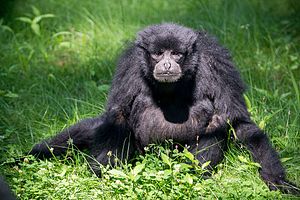Human
| Human | ||||||||||||
|---|---|---|---|---|---|---|---|---|---|---|---|---|

Siamang ( Symphalangus syndactylus ) |
||||||||||||
| Systematics | ||||||||||||
|
||||||||||||
| Scientific name | ||||||||||||
| Hominoidea | ||||||||||||
| Gray , 1825 | ||||||||||||
| Familys | ||||||||||||
|
The human or great apes in the broader sense (hominoidea) are a superfamily within the primates . They include the gibbons (the so-called lesser apes = Hylobatidae) and the (Great) apes (hominids), which in the biological system and the human ( Homo sapiens belongs).
features
The individuals of all types of the human have two common characteristics: the tail is absent, and their posterior molars show the dryopithecine pattern .
The human species include both species with relatively small individuals and the largest living primates: The weight of smaller gibbons is around four kilograms, male gorillas can weigh up to 200 kilograms. The shoulder joint is compared with other primates rearwardly moved, accordingly, that is clavicle extended and the shoulder blade dorsal side attached - which provides for a great mobility of the upper arms. The arms of the humans are - except in humans - longer than the legs, which is untypical for monkeys. The skull is voluminous, the brain is relatively large.
Like all Old World monkeys, the humans have 32 teeth, the tooth formula is I 2 - C 1 - P 2 - M 3.
Distribution and way of life
"The cradle of the Hominoidea lies in the early Miocene of East Africa " (that was around 20 million years ago), whereby all early Miocene forms are referred to as "archaic or tribe Hominoidea ". Already in the middle Miocene (around 15 million years ago) the human species had developed a considerable wealth of forms and also settled in Asia and Europe . The orangutans ( ponginae ) in Asia, the later extinct Dryopithecines in Europe and the homininae in Africa dates back to this time .
One of the oldest known genera is Proconsul . Other species that are among the early human-like, are Dryopithecus , pliopithecus , Laccopithecus , Morotopithecus , Turkanapithecus , Nyanzapithecus , Afropithecus , Equatorius , Nacholapithecus , Otavipithecus , Pierolapithecus , Griphopithecus , lufengpithecus , Sivapithecus , Ramapithecus , Chororapithecus , Ankarapithecus , Nakalipithecus , Hispanopithecus , Oreopithecus , Khoratpithecus , Samburupithecus , Mesopithecus and Ouranopithecus . However, the number of fossils from this epoch is still very limited, so that neither their relationships nor the lines of development can currently be reconstructed with sufficient reliability.
Today the distribution area of the humans (with the exception of humans) is limited to central Africa and Southeast Asia . Their habitats are predominantly forests, only the common chimpanzee occasionally stays in savannahs .
The human-like are diurnal and, depending on the genus, either tree or ground-dwelling. Your social behavior is variable; unlike many other primates, the groups are not organized around closely related females. Humans feed primarily on plants, but chimpanzees and humans are omnivores.
Systematics
The human-like among the Old World monkeys and the sister group of tailed Old World monkeys, of which today only the family of the Cercopithecidae exists. Within the human species - which, in contrast to the species of their sister group, have no tail - two ( recent ) families that still exist today are distinguished: on the one hand the gibbons and on the other hand the great apes , which also include humans and their extinct ancestors (the hominini ) counting. Their relationship to other primate taxa is shown in the following cladogram :
| Monkey (anthropoidea) |
|
|||||||||||||||||||||
|
|
See also
literature
- Thomas Geissmann : Comparative Primatology. Springer-Verlag, Berlin et al. 2003, ISBN 3-540-43645-6 .
Web links
Individual evidence
- ↑ Volker Storch, Ulrich Welsch, Michael Wink: Evolutionary Biology. Springer, 2001, p. 442, ISBN 978-3-540-41880-1
- ↑ Winfried Henke , Hartmut Rothe : Stammesgeschichte des Menschen. Springer, Berlin 1999, p. 55
- ↑ Daniel Demiguel, David M. Alba and Salvador Moyà-Solà: Dietary Specialization during the evolution of Western Eurasian hominoids and the Extinction of European Great Apes. In: PLoS ONE. 9 (5): e97442, 2014, doi: 10.1371 / journal.pone.0097442
- ↑ Isaiah Nengo, Paul Tafforeau, Christopher C. Gilbert a. a .: New infant cranium from the African Miocene sheds light on ape evolution. In: Nature. Volume 548, 2017, pp. 169-174, doi: 10.1038 / nature23456
- ↑ The family of Proconsulidae was first described by Louis Leakey : East African Hominoidea and the classification within this super-family. In: Sherwood L. Washburn (Ed.): Classification and Human Evolution. Wenner-Gren, New York 1963, pp. 32-49. In addition to the genus Proconsul, it also includes fossils of other, similarly old species, but all assignments are controversial due to the few finds so far.